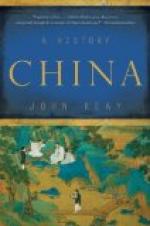The importance of alternating crops was also discovered and from now on, the old system of fallow cultivation was given up and continuous cultivation with, in some areas, even more than one harvest per field per year, was introduced even in wheat-growing areas. Considering that under the fallow system from one half to one third of all fields remained uncultivated each year, the increase in production under the new system must have been tremendous. We believe that the population revolution which in China started about 1550, was the result of this earlier agrarian revolution. From the eighteenth century on we get reports on depletion of fields due to wrong application of the new system.
Another plant deeply affected Chinese agriculture: cotton. It is often forgotten that, from very early times, the Chinese in the south had used kapok and similar fibres, and that the cocoons of different kinds of worms had been used for silk. Real cotton probably came from Bengal over South-East Asia first to the coastal provinces of China and spread quickly into Fukien and Kwangtung in Sung time.
On the other side, cotton reached China through Central Asia, and already in the thirteenth century we find it in Shensi in north-western China. Farmers in the north could in many places grow cotton in summer and wheat in winter, and cotton was a high-priced product. They ginned the cotton with iron rods; a mechanical cotton gin was introduced not until later. The raw cotton was sold to merchants who transported it into the industrial centre of the time, the Yangtze valley, and who re-exported cotton cloth to the north. Raw cotton, loosened by the string of the bow (a method which was known since Sung), could now in the north also be used for quilts and padded winter garments.
5 Commercial and industrial developments




